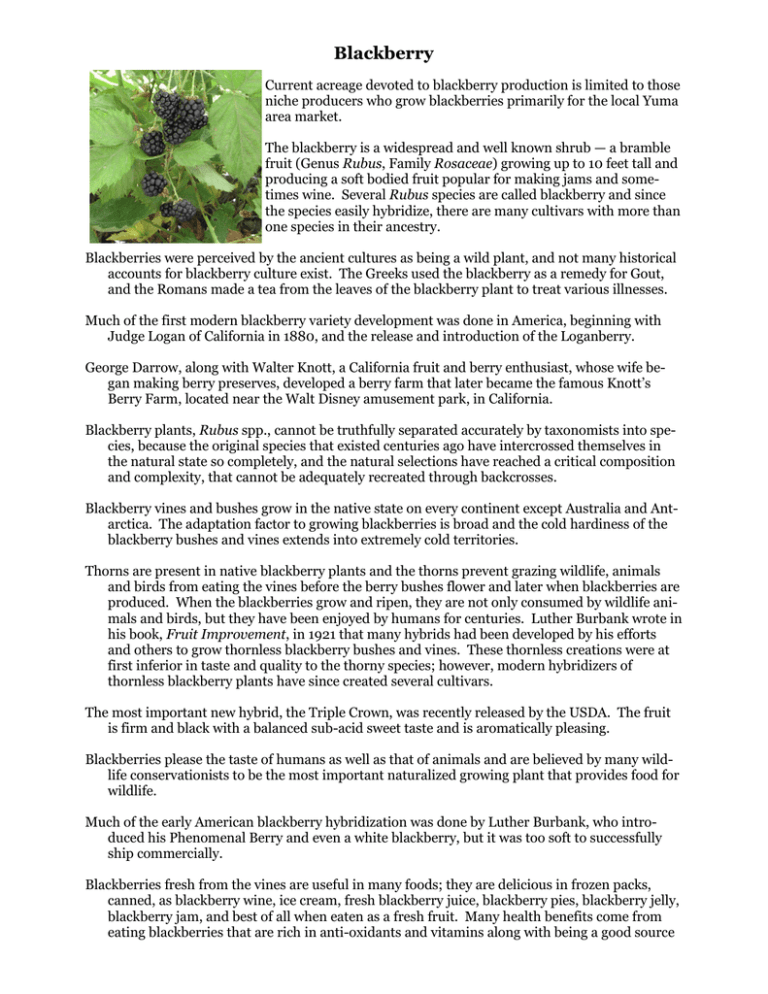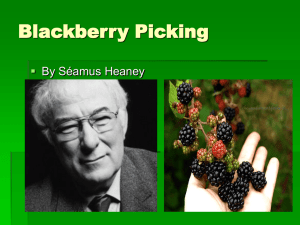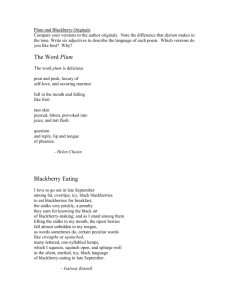Blackberry
advertisement

Blackberry Current acreage devoted to blackberry production is limited to those niche producers who grow blackberries primarily for the local Yuma area market. The blackberry is a widespread and well known shrub — a bramble fruit (Genus Rubus, Family Rosaceae) growing up to 10 feet tall and producing a soft bodied fruit popular for making jams and sometimes wine. Several Rubus species are called blackberry and since the species easily hybridize, there are many cultivars with more than one species in their ancestry. Blackberries were perceived by the ancient cultures as being a wild plant, and not many historical accounts for blackberry culture exist. The Greeks used the blackberry as a remedy for Gout, and the Romans made a tea from the leaves of the blackberry plant to treat various illnesses. Much of the first modern blackberry variety development was done in America, beginning with Judge Logan of California in 1880, and the release and introduction of the Loganberry. George Darrow, along with Walter Knott, a California fruit and berry enthusiast, whose wife began making berry preserves, developed a berry farm that later became the famous Knott’s Berry Farm, located near the Walt Disney amusement park, in California. Blackberry plants, Rubus spp., cannot be truthfully separated accurately by taxonomists into species, because the original species that existed centuries ago have intercrossed themselves in the natural state so completely, and the natural selections have reached a critical composition and complexity, that cannot be adequately recreated through backcrosses. Blackberry vines and bushes grow in the native state on every continent except Australia and Antarctica. The adaptation factor to growing blackberries is broad and the cold hardiness of the blackberry bushes and vines extends into extremely cold territories. Thorns are present in native blackberry plants and the thorns prevent grazing wildlife, animals and birds from eating the vines before the berry bushes flower and later when blackberries are produced. When the blackberries grow and ripen, they are not only consumed by wildlife animals and birds, but they have been enjoyed by humans for centuries. Luther Burbank wrote in his book, Fruit Improvement, in 1921 that many hybrids had been developed by his efforts and others to grow thornless blackberry bushes and vines. These thornless creations were at first inferior in taste and quality to the thorny species; however, modern hybridizers of thornless blackberry plants have since created several cultivars. The most important new hybrid, the Triple Crown, was recently released by the USDA. The fruit is firm and black with a balanced sub-acid sweet taste and is aromatically pleasing. Blackberries please the taste of humans as well as that of animals and are believed by many wildlife conservationists to be the most important naturalized growing plant that provides food for wildlife. Much of the early American blackberry hybridization was done by Luther Burbank, who introduced his Phenomenal Berry and even a white blackberry, but it was too soft to successfully ship commercially. Blackberries fresh from the vines are useful in many foods; they are delicious in frozen packs, canned, as blackberry wine, ice cream, fresh blackberry juice, blackberry pies, blackberry jelly, blackberry jam, and best of all when eaten as a fresh fruit. Many health benefits come from eating blackberries that are rich in anti-oxidants and vitamins along with being a good source of the minerals potassium, phosphorus, iron, and calcium. The distinction between blackberries and raspberries revolves around fruit characteristics. All bramble fruits are aggregate fruits, which mean they are formed by the aggregation of several smaller fruits, called drupelets. The drupelets are all attached to a structure called the receptacle, which is the fibrous central core of the fruit. In raspberries, the receptacle remains with the plant when fruit are picked, creating the hollow appearance of the harvested fruit. In blackberry, the drupelets remain attached to the receptacle, which comes off with the fruit when picked. A second distinction - raspberry drupelets are hairy and adhere to one-another, whereas blackberry drupelets are hairless and smooth. Blackberries are native to Asia, Europe, North and South America. However, blackberries grown in specific regions are largely derived from species indigenous to that region. Blackberries have been used in Europe for over 2000 years, for eating, medicinal purposes, and as hedges to keep out marauders. Most cultivars of blackberries, black raspberries, and raspberries are self-fruitful and do not require pollinators. There are two types of blackberries, erect and trailing. The primary difference is the growth habit of their canes. Erect blackberry fruit types have stiff, arching canes that are somewhat selfsupporting. Trailing blackberries, also called dewberries in the East, have canes that are not self-supporting. Blackberry fruit contain vast amounts of anthocyanins, which are found in the pigment that gives the berries their color. Anthocyanins are powerful antioxidants that help to reverse cell damage caused by free radicals, and are reported to be instrumental in preventing heart disease, cancer and strokes. Blackberry leaves are used in making blackberry tea and are used for treating non-specific acute diarrhea, as well as inflammation of the mouth and throat. It is also reported to be helpful in reducing blood sugar levels and is a good source of the vitamins C and E and the mineral, selenium. The fruit is very dark purple with smooth, fragile skin. In the middle of the cluster is a greenishwhite core that extends to almost the bottom of the berry. Blackberries can be easily confused with raspberries, but raspberries (including black raspberries) have a hollow center. The blackberry plant has many long, arching or trailing stems (called canes). Fruit is produced on two year old cane and when mature, the plant can reach up to 10 feet tall. The blackberry is actually an ancient fruit, prescribed by the Ancient Greeks for gout, the Native Americans for stomach ailments. There are lots of health benefits of blackberries. Blackberries have recently been recognized as a leading source of compounds thought to produce health benefits for women, due to their high concentrations of phytoestrogens. Phytoestrogens, literally “plant estrogens”, have been of interest to the scientific community because of their possible roll in prevention of both breast and cervical cancer. Studies now indicate that berries may contain some of the highest levels of phytoestrogens. Blackberries are considered to be an astringent because of their high tannin content. Studies show that tannins tighten tissue, lesson minor bleeding, and may help to alleviate diarrhea and intestinal inflammation. German health authorities recommend blackberries for mild infections including sore throats and mouth irritations. Traditionally, blackberries have been used to alleviate hemorrhoids because of their rich tannin content. Kurt Nolte is an area agriculture agent with the Yuma County Cooperative Extension. He can be reached at 928-726-3904.







